Holy nights
In the latter half of the sixteenth century, with the new religious sensibility born of the Counter-Reformation, night scenes relating to the life and Passion of Christ became common. In the wake of Titian, new-generation artists such as Tintoretto or Bassano would make night scenes into a kind of trademark of Venetian painting.
Titian’s first real nocturne was the Saint Jerome in the Musée du Louvre. While he himself appeared to regret the incomplete nature of his work, he embarked upon a new technique of the dissolution of matter through light using broad brushstrokes in an ever-increasing naturalistic pursuit. Until the end of his life he would continue to explore the disintegration of matter in light, particularly in night settings. The finest artists of the following generation were to take over and revise this tragic effect of light and color.
From the outset, Tintoretto’s night scenes were imbued with supernatural lighting and colors distorted by bold contrasts of light. Throughout his long career, he would resort to lively effects of lighting, adding a sense of drama to his breathtaking compositions.
With his penchant for bright hues and crystal-clear luminosity, Veronese would not allow his style to be influenced by Titian’s experimentations with light until after the latter’s death. His nighttime settings then took on a denseness that reflected the dramatic tension; his technique became more fragmented, with stronger and more expressive contrasts.
Jacopo Bassano was a direct heir to Titian’s experimentations with light in the relationship of light and matter in night scenes that were gradually to take on a harrowing sense of drama. Forms carved from color and lashed with light would spring out of the darkness, conveying a distressing sense of anguish.
More than anyone else, Venetian painters worked on representing the paradox of Christ’s resurrection—not only did Christ rise, but he was dead for three days. The issue was therefore not to paint him as if he were alive but to attempt to express this passage via death.
By plunging certain daylight scenes—such as the Annunciation, Christ Crowned with Thorns, or the martyrdom of saints—into an artificial half-light, artists would emphasize the tragic nature of the representation. Night combines with day, and death with life. Emotion is not conveyed through iconography alone; the colors themselves are imbued with expressiveness and pathos. The artists create a whole interplay of hues that are absorbed by dark shades as if dragged down by death. The scene’s orchestration, colors, and chiaroscuro interplays are all geared to casting the viewer into a harrowing state of contemplation.
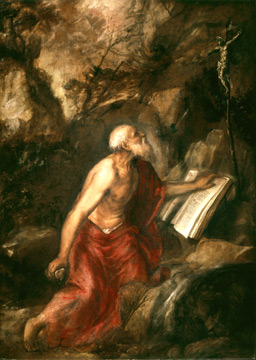 Learn more+
Titian
, Saint Jerome in the Wilderness
Learn more+
Titian
, Saint Jerome in the Wilderness
Madrid, Museo Thyssen-Bornemisza
(Inv 1933.4)
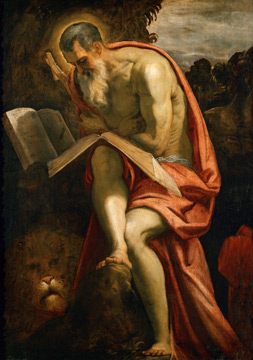 Learn more+
Tintoretto
, Saint Jerome in the Wilderness
Learn more+
Tintoretto
, Saint Jerome in the Wilderness
Vienna, Kunsthistorisches Museum
(Inv GG-46)
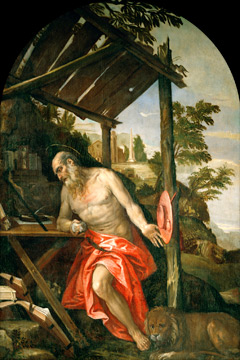 Learn more+
Veronese
, Saint Jerome in the Wilderness
Learn more+
Veronese
, Saint Jerome in the Wilderness
Venice, Gallerie dell'Accademia
?
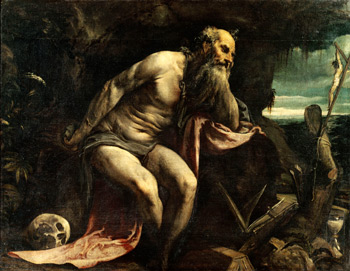 Learn more+
Jacoppo Bassano
, Saint Jerome
Learn more+
Jacoppo Bassano
, Saint Jerome
Venice, Gallerie dell'Accademia
(Inv N652)
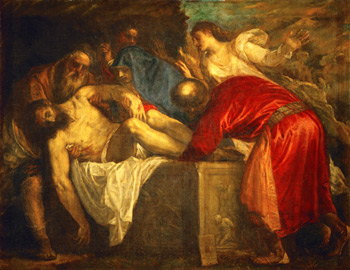 Learn more+
Titian
, Entombment
Learn more+
Titian
, Entombment
Madrid, Museo Nacional del Prado
(inv P00440)
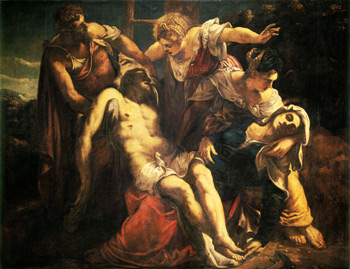 Learn more+
Tintoretto
, Lamentation over the Dead Christ
Learn more+
Tintoretto
, Lamentation over the Dead Christ
Venice, Gallerie dell'Accademia
(Inv 217)
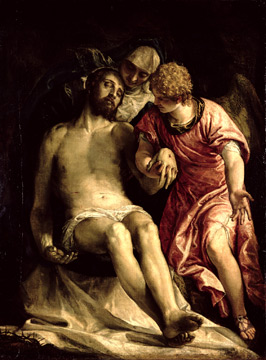 Learn more+
Veronese
, Dead Christ
Learn more+
Veronese
, Dead Christ
St. Petersburg, Hermitage Museum
(Inv GJ-49)
Close x
Titian, Saint Jerome in the Wilderness
Madrid, Museo Thyssen-Bornemisza
(Inv 1933.4)
Titian produced this painting toward the end of his life. While he partially reworks the composition of a previous work, this Saint Jerome testifies to his change in style. The saint's body is portrayed through more broken, almost impressionistic brushwork while the landscape forms an indeterminate dazzling sight in which earth, sky, trees, and rocks mingle in an eddy of light.
© Museo Thyssen-Bornemisza, Madrid

Click on the picture to zoom: Saint Jerome in the Wilderness (new window)
Close x
Tintoretto, Saint Jerome in the Wilderness
Vienna, Kunsthistorisches Museum
(Inv GG-46)
Tintoretto has chosen to depict his Saint Jerome meditating on the Bible in the glow of twilight and accompanied by a placid lion. The saint's powerful Michelangelesque anatomy with its sculptural lines that seems to rise out of the setting may be linked with the notion of paragone (comparison between painting and sculpture and the pre-eminence of one over the other).
© Erich Lessing, Vienna

Click on the picture to zoom: Saint Jerome in the Wilderness (new window)
Close x
Veronese, Saint Jerome in the Wilderness
Venice, Gallerie dell'Accademia
?
This Saint Jerome is a later work in which Veronese's classic serenity gives way to a tragic dimension. The early summer evening sky and the tranquil landscape with its small church and obelisk stand in contrast to the figure's dramatic appearance with his reddened eyes and sculptural chest scarred by self-flagellation.
?

Click on the picture to zoom: Saint Jerome in the Wilderness (new window)
Close x
Jacoppo Bassano, Saint Jerome
Venice, Gallerie dell'Accademia
(Inv N652)
Bassano has cast off the mannerist legacy of his early days. The saint's body, showing its marks of age in the glints of light, his sorrowful countenance, and the dark atmosphere of the menacing sky herald the realist painting of the seventeenth century, notably of Caravaggio and Ribera.
© 1990 Photo Scala, Florence - courtesy of the Ministero beni e Att. Culturali

Click on the picture to zoom: Saint Jerome (new window)
Close x
Titian, Entombment
Madrid, Museo Nacional del Prado
(inv P00440)
The composition is inspired by examples taken from sculpture. Bright patches (red, blue, and white) punctuate the virtually monochrome color. The figures—apart from Christ's sculptural physique—appear to be sucked up by the landscape and the setting around them. The work is characteristic of the new style created by Titian in his old age.
© Museo Nacional del Prado, Madrid

Click on the picture to zoom: Entombment (new window)
Close x
Tintoretto, Lamentation over the Dead Christ
Venice, Gallerie dell'Accademia
(Inv 217)
In this scene in which the drama is highlighted by very tight framing and an intense chiaroscuro, Tintoretto orchestrates the arrangement of the dead Christ and the unconscious Virgin so as to provide a sense of symmetry between the two bodies falling in opposite directions, evoking separation and death. A certain influence of Titian's late style is apparent here.
© Scala, Florence

Click on the picture to zoom: Lamentation over the Dead Christ (new window)
Close x
Veronese, Dead Christ
St. Petersburg, Hermitage Museum
(Inv GJ-49)
The monumental Dead Christ, foreshortened so as to be seen from below, with its contrasts between the black ground and the changing colors of the drapery mottled with divine light issuing from the right-hand side, falls within the tradition of a luminism based on more muted brushwork—strongly contrasting and expressive—typical of Veronese's late period.
© Bridgeman Giraudon, Paris

Click on the picture to zoom: Dead Christ (new window)















